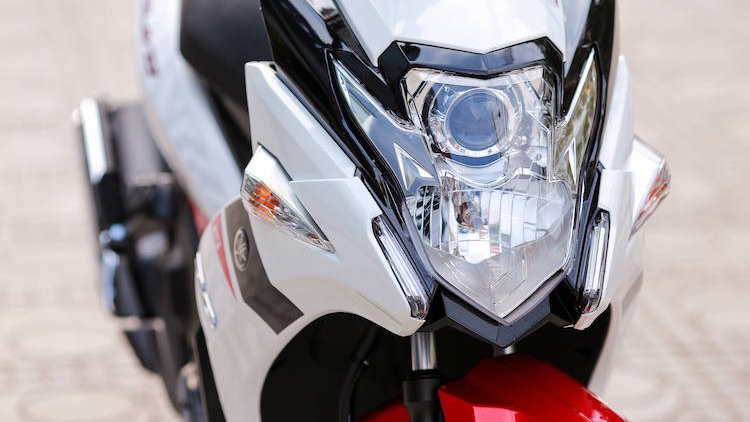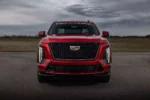The origin of the Halogen bulb, one cannot fail to mention the traditional filament bulbs used in cars in the 1940s, which were gradually replaced by halogen bulbs in the late 1970s. They are still housed in sealed capsules, but the light is significantly improved. In the 1980s, it became possible to replace just the bulb without changing the whole lamp. At this point, car and motorcycle manufacturers were able to design different styles and types of headlights.
It must be admitted that for many motorcycle manufacturers in Vietnam, equipping their products with a halogen bulb system still seems to be a given. This type of bulb has a relatively cheap production cost and a simple construction.
.jpg) Original headlamp using Halogen bulb on the Honda SH 2016
Original headlamp using Halogen bulb on the Honda SH 2016
On the other hand, each halogen bulb also has an average lifespan of up to 1,000 hours under normal environmental conditions, long enough for users not to worry about regular replacement and repair. But if they do, the cost of replacement is only about $20-30 for a complete set of bulbs.
However, in Vietnam, motorcycle users, especially motorcycle enthusiasts, have gradually stopped using this type of bulb and instead prefer to use bulbs that provide higher lighting efficiency, which of course have more complex structures and higher investment costs.
A few facts about Halogen bulbs
To create the core part of the bulb, manufacturers will use a large amount of quartz glass to make the bulb because this material can withstand very high temperatures and pressures (about 5 to 7 bar), making the filament brighter and the bulb’s lifespan longer than regular filament bulbs.

Back to the early period with classic headlights using sealed capsules. When the bulb burns out, it would be a waste to replace the entire headlight, so you should only replace the bulb. Different manufacturers have different standards, so when choosing, pay special attention to the socket, shape, size, and color temperature. The original bulb on motorcycles usually works in the temperature range of 4,100-4,300 Kelvin, creating light that is similar to daylight. If the emitted light has a slightly blue or purple color, it is around 5,000-6,000 Kelvin. A higher color temperature does not mean the light will be brighter, it simply changes the color of the emitted light.
Compared to traditional filament bulbs, halogen bulbs have significantly longer lifespans. By using an additional halogen gas, halogen bulbs prevent the phenomenon of evaporation of the filament due to metal vaporization at high temperatures, which leads to the breakage of the filament. Another note is to always be careful when using cheap or unknown origin bulbs. They may quickly burn out or have the filament placed in the wrong position, reducing the brightness at night.
Disadvantages of Halogen bulbs
Although they have many clear advantages such as simple construction, easy replacement and repair, and relatively cheap replacement costs, Halogen bulbs also have several drawbacks that can be bothersome to those who demand more from their basic means of transportation.
.jpg) Headlight using Halogen bulb on Piaggio Medley
Headlight using Halogen bulb on Piaggio Medley
Firstly, let’s talk about the construction of halogen bulbs. These bulbs are made of a type of glass that can withstand very high temperatures, with a filament made of tungsten wire, surrounded by gas, usually argon and nitrogen. To emit light, the filament will receive a certain amount of electrical energy transferred from the battery, heating up to around 2,500 degrees Celsius. Therefore, it is clear that a large amount of electrical energy from the battery is wasted as heat energy, causing the outer lens’ temperature to increase significantly and potentially posing a danger when touched after prolonged use.
After using a halogen bulb for a while, the high temperature will cause the tungsten wire filament to slowly vaporize, leaving deposits on the glass part of the bulb, which can puncture the thin glass layer and reduce the bulb’s performance.
Although this type of bulb has a relatively simple maintenance and replacement process, during the bulb replacement process, the carelessness of the technician can cause the reflective and light-amplifying coating to become dirty, resulting in a decrease in the lighting function.
Another issue is the reaction of halogen bulbs with certain substances. For example, when replacing a broken bulb, you should not touch the glass envelope. The salt in your sweat can reduce the bulb’s lifespan.
Replacement solutions
Nowadays, for motorcycle enthusiasts, replacing the lighting system for their motorcycles, or also known as “customizing headlights,” is no longer a difficult task. In only Hanoi, there are quite a few facilities and centers that specialize in customizing the original halogen headlight system of motorcycles, mainly by replacing it with a Bi-xenon or Projector system.
Replacing the original halogen bulb headlight assembly on a motorcycle with a Bi-xenon or Projector system will take quite a bit of time and come with a not-so-cheap cost. Nevertheless, the advantage of Bi-xenon headlights is energy savings and much brighter light compared to regular halogen headlights. However, this is also its weakness, as the very bright light of the xenon bulb can blind oncoming drivers. Bi-xenon headlights have a longer lifespan than halogen bulbs. Under normal conditions, xenon bulbs have an average lifespan of about 2,000 hours.
.jpg) Headlight reflector of the Honda SH was replaced with a Projector system taken from the Audi Q5
Headlight reflector of the Honda SH was replaced with a Projector system taken from the Audi Q5
Recently, quite a few mid-range to high-end motorcycles have refused to use the old-generation halogen headlight system. As a prime example, the 2016 Honda Airblade model applies full LED technology. LED stands for Light-Emitting Diode. The construction and illumination process of LED bulbs are quite complex. In general, LED bulbs are based on semiconductor technology, in which the movement of electrons produces radiation of various colors depending on the material within the semiconductor chip.
 Full LED headlight of the 2016 Honda Airblade
Full LED headlight of the 2016 Honda Airblade
 Headlight that combines a Projector bulb with a Halogen bulb on the Yamaha Nouvo
Headlight that combines a Projector bulb with a Halogen bulb on the Yamaha Nouvo
In summary, nowadays, different manufacturers continuously introduce new technologies to demonstrate their leading capabilities, and headlights are not left out of this game. From simple acetylene bulbs in 1980 to complex LED and laser technologies today, this has been a journey of development.
Technologically speaking, most users believe that the newer the technology, the more superior it is, namely Bi-xenon or Projector is the best type of headlight currently. However, each type has its own advantages and disadvantages, and there is no such thing as a perfect type of headlight.
- The risks of “modded” motorcycle lights
- Laser headlight technology on the BMW i8
- From Bi-Xenon to “5-in-1” headlights
Trung Hieu (Trithucthoidai.vn)



































![[CAR REVIEW] Mazda CX-5 2018 after 3+ years: Areas for Improvement](https://vnauto.net/wp-content/uploads/2024/02/xehay-mazdacx5cu-25082022-2-100x70.jpg)
